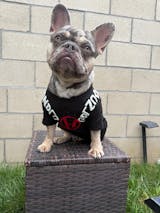Does Your Dog Have A Tail Pocket?
Every dog owner knows that taking care of your dog is a huge responsibility. And, sometimes, our dogs require extra care and attention outside of the typical walking, feeding, and grooming routine to keep them in their best shape.
This can be especially true when it comes to caring for certain wrinkly dog breeds. One of the lesser-known health considerations of wrinkly dogs is tail pockets. Before we jump into the care and maintenance of this anatomical oddity, first let’s discuss exactly what a tail pocket is and how to know if your dog has one.

What is a Dog Tail Pocket?
Many dog breeds are covered in wrinkles (adorable, right?), and those wrinkles can sometimes be found in surprising places. The tail pocket is a small indentation or pocket – located just under the dog’s tail and created by a fold of wrinkly skin. Sometimes, it can be on the top of the tail, or around the tail depending on the dog. Most often, tail pockets resemble a dimple on your dog’s butt until you take a closer look.
What Dog Breeds Have Tail Pockets?Tail pockets are found in several small dog breeds. The more wrinkled the skin on the dog, the more likely it is to have a pocket.
Some dog breeds prone to having tail pockets are:
- English Bulldogs
- French Bulldogs
- Pugs
In most of these breeds, the type of tail also plays a factor in whether a tail pocket is present or not. For instance, tail pockets are found more frequently on dogs with tight, corkscrew tails more so than straighter tails.
How to Check if Your Dog Has a Tail Pocket
Not all dogs in the breeds listed above will have a tail pocket. Finding your dog’s tail pocket – if they have one – is easy enough to do. Simply run your finger under your dog’s tail to see if there is an indentation of skin present, or not. Wrinkly puppies are not always born with a tail pocket. In some breeds, such as French Bulldogs, a tail pocket may not develop until they are at least six months old, or until they are fully grown into their wrinkly glory. Some dogs never develop a tail pocket at all. Much of it depends on how wrinkly the dog is and the anatomy of the tail.
What it Means For your Dog’s Health
Dog tail pockets aren’t as obvious as your dog’s other skin folds and wrinkles that require special attention, but they are just as important to care for. On their own, tail pockets are not a reason to be concerned. Tail pockets are a perfectly natural occurrence, much the same as your dog’s other wrinkles! However, like those other wrinkles, tail pockets can trap dirt, fungus, and other irritants within the folds. If you don’t clean your dog’s tail pocket regularly, it can cause a lot of discomfort for your dog.
Symptoms of an Irritated Tail Pocket
Here are some notable symptoms to look for: At first, you may observe flaky, dry skin around the tail that can advance to red, itchy irritation if left untreated. As the build-up of dirt, grime, and natural oils increase, you may begin to notice an unpleasant smell from the area. Your dog may also drag themselves on the floor to alleviate their discomfort.
If this is the case, it’s an indicator that your dog’s tail pocket may be in danger of bacterial or yeast infections that can escalate quickly if not addressed. It is also uncomfortable and painful for your pup. However, this doesn’t have to be the case! A far easier option is to learn how to clean and care for your dog’s tail pocket properly and keep it from getting irritated.
How to Take Care of Your Dog's Tail Pocket
As with most health-related conditions, prevention goes a long way. This is especially true when it comes to taking care of your dog’s tail pocket. A good tip is to incorporate cleaning your dog’s tail pocket into your regular bathing or cleaning routine. The frequency of cleaning the tail pocket will depend on your dog, so it’s a good idea to keep an eye (and a nose) out for it.
The trick is to clean the tail pocket regularly, so your dog doesn’t suffer from any potential skin irritation or pain. Here’s how you do it:
Clean the AreaUsing a Wrinkle Wipe, you want to carefully & thoroughly clean the area. If this is the first time you’ve done it, it may take some additional time. Remember that the tail pocket is sensitive! So be gentle as you clean out the pocket and make sure you get it entirely clean.
Squishface Wrinkle Wipes contain phytosphingosine, a pro-ceramide with anti-inflammatory and antibacterial properties that helps to rebuild the natural ceramides found in the skin barrier, and is critical in helping to keep the skin healthy. No other dog wipes on the market contain this key ingredient, and that’s part of what makes Squishface Wrinkle Wipes superior to any other comparable product!
Thoroughly Dry Your Dog’s Tail Pocket
Once you’ve thoroughly cleaned out your dog’s tail pocket, make sure you let the area dry completely. You can use a tissue or dry cloth for this process. It is important to let the area dry completely to prevent any moisture from forming.
Apply Wrinkle Paste on the Area
Because the tail pocket area can become infected so easily, it’s essential to apply Squishface Wrinkle Paste to help prevent any nasty infections from forming. The thick, creamy formula is designed to stay between the folds of your dog’s skin. Adding a water-resistant barrier, Wrinkle Paste helps repel fungus, bacterial, and excessive moisture between cleanings. It also helps soothe any skin irritation your pup may have. It’s fragrant-free, easy to use, and completely safe for your pup!
If you’re the parent of a wrinkly pup, you know how important it is to be mindful of the wrinkles and folds that add to the personality and cuteness of your favorite four-legged friend. Tail pockets, while a unique part of dog anatomy, are easy to care for if you have the right information and tools. If you want to make sure your pup has the best care for their most sensitive spots, get some Squishface Wrinkle Paste and Wrinkle Wipes today!







